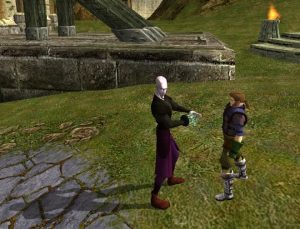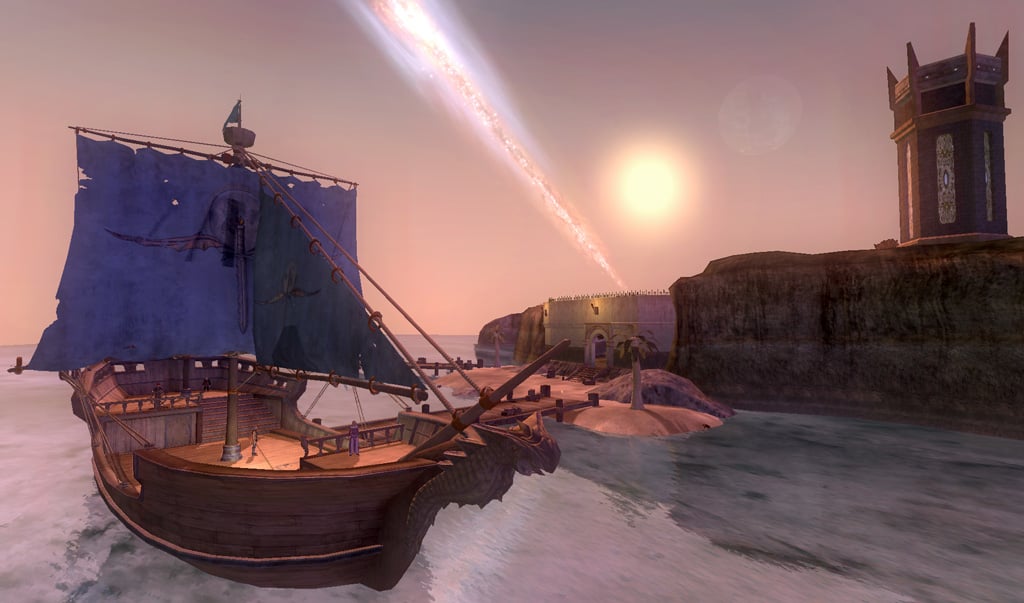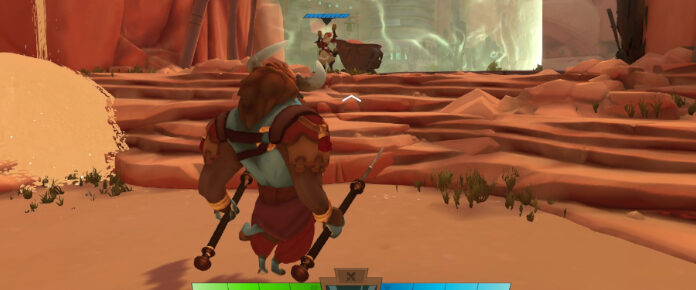
As this year’s GDC coverage is winding down, I am finally coming to the topic I saved for last: community. MMOs are more than just multiplayer. We attract the “alone together” people more than the “FPS hero” crowd in our comments section for a reason; MMOs are virtual worlds. They’re a digital space inhabited by other people. We may not talk to them, but we watch and listen. Maybe we engage, maybe we group, maybe we guild. We do stuff in a shared environment because we think, or hope, we’re part of a larger system.
And this is why we need to talk about cross-platform communities and the strength of in-game, embedded community tools. As social media rises and mobile crashes against our PC fortress, increased console cross-play should be a reminder that we’re all gamers, and (some) developers are finally getting that.
Bringing people together
The panel on bridging cross-platform communities, held by Eric Cleaver (NetEase Games), EM Stock (NetEase Games), Linda “Brasse” Carlson (Trion Worlds), John Bergman (Guild Software, Inc.), and Troy Hewitt (uGen World) was incredibly revealing. Getting down to “Brasse”-tacks, Carlson flatly stated that cross-platform play just can’t be done in some cases because Sony and Microsoft won’t play nice together. This has always been a thing, and various developers tell me yearly which of the two is now saying they’ll work with the other guy but the other guy is now saying they don’t want to join forces.
Now, in some sense, this is understandable. As Carlson notes, both companies are trying to protect their market share and keep people loyal to them. The problem is that most of us want to play together (within reason). Different input methods suck when one has an advantage over the other, but it’s still something we seek. In fact, even though I generally know I’ll be disappointed, I still often ask about cross-play when I hear a PC game will be on console(s) as well, and I’m frequently disappointed.
And I should be. As the speakers noted, iPhone and Android gamers don’t have to worry about barriers to cross-play. The fact is, even though synchronous, AAA multi-gaming on mobile devices is still trying to penetrate western markets, different phone operating systems play nice together. Heck, you can often throw them together with people playing on browsers and everything’s still cool. Mobile isn’t alone in this, either. In the VR realm, HTC flat out said that Oculus’ insistence on exclusive titles hurt the overall market. The fact that I can play with Vive users and still feel like certain VR titles are “dead” only reinforces the fact that sharing the market it better for everyone.
But maybe that wall is coming down. While Microsoft has allowed cross-platform between its game console and PC operating system, console veteran Nintendo has come out of left field to allow not only PC crossplay in some cases but cross-play with PC and Xbox! Considering Nintendo’s current console is also mobile, I suspect Nintendo may be posed to act as a third faction to (hopefully) bring the console wars to an end (and maybe Nintendo games to PC? Cross your fingers!).
Is that too optimistic? Maybe. As much as a unified gaming platform would make gaming more accessible (and possibly cheaper), it’s still a long way away, and not just because of company pride. Each platform has its own strengths, weaknesses, and limitations, not just in handling games but in ability to adapt from one input method to another.
Problems in paradise
Maybe this has happened to you before: The game you’re playing announces it’ll suddenly be on a new platform, and then content starts to dry up. Fans argue back and forth about which platform is getting the best experience, and which is costing development time for the other, and you know what? Both sides might be right. Our panelists, all with community manager backgrounds, are more than just PR and marketing people. They understand the developer teams, intentions, and timelines.
Yes, with some titles, the team isn’t big enough to work on the new dungeon and overhaul the UI for mobile. Yes, the PC game gets things earlier because it’s the firstborn, the main coders are used to programming for it, and sweet-baby-Blackthorn are mobile drivers unstable!
Then there’s marketing and monetization. Sometimes, when a fan loves a game but that game gives preference to another platform, it creates a space for anger. It’s hard for a CM to just say, “Sorry, we’re releasing on Platform X first because the advertising money we’re saving by doing so gives us a budget to hire new people for more content!” so it’s just “business purposes.”
EM Stock said that part of this is to help keep platform bias out of the picture as long as possible. It’s an issue that’s linked with general fandom, where fans think with their heart instead of their brain. Keeping people in the dark might just be seen as a necessary evil, but that’s another discussion entirely. What is important is that companies shouldn’t be afraid to release on multiple platforms just because they want to avoid the work/drama. Several panelists noted that despite harsh words, most fan complaints nearly disappeared once the game was available on the system of their choice because all they want to do is play! Realizing this, it’s much easier for a CM to let fan-rage wash over until they have access to their version of the game.
How to deal with this, server outages, and perceived favoritism varies. Carlson felt that, at the least, you need to have some kind of compensation ready for those who are affected. Other CMs suggested to reward the player base as a whole, and I feel like I have to agree. As I’m getting into some mobile communities, being rewarded with, say, a longer event for everyone when I was affected isn’t half bad. In fact, I wonder if I feel less animosity towards my iProduct gamers because I get so many bonuses when their systems hiccup or fail, and that’s the point of all this: bringing different gamers together.
However, mobile users often have more in common with each other than people playing on PC, who can play in similar ways to mobile users even if it’s not a simple browser-based game, but consoles and quick menu navigation don’t really feel as if they go hand-in-hand. The input method is important, but people like Hewitt are actually making PC/Mobile/VR cross-platform games, and any CM can tell you that it’s not just input that divides us but gaming culture.
Communicating across borders
Let’s think about patch notes for a moment. As PC gamers, we’re used to huge, detailed notes to pore over. However, as Hewitt noted, mobile developers don’t get that kind of space. Their platform publishers force them to keep their notes short. How do you handle this when you have a game on multiple platforms all getting the same patch?
You may think you can just put a link to the full notes in your description, but that ignores different styles those users are more accustomed to. Stock, for example, notes that mobile users are much more used to short explanations, with visuals being the best form of communication if you can get them to work. Social media may work for them and PC users to a degree, but the latter likes to engage with the developers in a more verbose way that social media isn’t right for. And Carlson is adamant about keeping the Trion forums online and bringing all players to them.
In fact, most of the CMs agreed on this (and so do players!). Having at least one area where the developers can leave notes that anyone can access makes life easier for developers. Having specific sections for each platform helps keep things neat. From there, steer people to that central communication tool.
Even better, though, is finding community leaders to help with this. Passionate players will find ways to communicate in different styles with their fellow player, so if users aren’t getting written instructions, you could work with a fan-streamer to get a visual tutorial made.
This is especially difficult when it comes to in-game communication. Maybe it’s because we mostly cover MMOs, but I’ve mentioned my need for an MMO to have a communication system, and I’m going to stand by that in this context. “Multiplayer” feels tacked on if I’m told there are tons of players but can’t see or interact with them. That’s what the No Man’s Sky drama was about, right?
As Stock mentioned that mobile users seem to prefer to keep things short and visual, social media integration is a great idea for mobile games. In fact, LINE (think WhatsApp for Asian markets, especially Japanese) has been doing this for awhile and recently came out with a new platform to support developers, so clearly our speakers know what they’re saying. But from what the MOP community has shown in the past (and present!), you folks seem to prefer forums and in-game chat systems to voice chat. I can’t imagine the console crowd putting down their controllers and typing angrily at me when they have voice chat.
What this illustrates is cultural divides within the gaming platforms that would still affect us if we were all able to play together, even if a game solved the control input issue. It also creates challenges, especially when trying to teach users how to submit a good bug report or why a certain exploit had to be fixed. As much as a community may love Instagram, all the CMs present agreed it’s terrible as a communication platform.
This is all assuming your game launches as cross-platform, and that’s uncommon. As Hewitt noted, one thing that can be helpful is having the first platform mentor the new one. People make guides for what to expect, but some also switch to the new platform and create guides to help the new people out. Even better, a good developer can listen to their community’s feedback to try to address potential issues before they become, well, actual issues.
When something goes wrong, a company needs to do damage control. I don’t just mean with bugs players may be filing en masse, but server outages or negative news. Relying on email mostly only works with the PC crowd, we’re told. Again, the idea is to funnel players to a single area on the internet where developers can easily go through community feedback in an organized fashion or disseminate “The word” for other players to pass around.
While Carlson loves getting back to the roots of our genre with in-game presence and announcements, those moments can be fleeting. They’re cool and I wish developers would listen to her suggestion, but her points on forums are probably more practical for most developers. However, Nicolas Nottin (flaregames GmbH) held a separate panel that takes this one step further: having an embedded platform.
All in the same boat
Let’s say that, to make cross-platform and all its messiness – ignoring input methods, preferred communication styles, UI adaption issues, release date issues, monetization restriction differences, login options, outsourcing community management and/or bug fixing, bugs unique to specific platforms – work the best, what you really need is a solid central communication hub.
I think, as MMO players, we can agree on this. After all, our genre was born from the MUD, Multi-User Dungeons that were text-based. All people originally had was a centralized communication platform. So when Nottin says he increased community and outreach by three times after creating an embedded community hub for the game Zombie Gunship Survival, we probably aren’t terribly surprised. In theory, it should work quite well.
Imagine having a kind of in-game lobby or diary where, in-world, your character was accessing forums, fan art, fan fiction, patch notes, developer insights, tutorials, ciphers and/or ARGs hinting at the next expansion’s content. It could do a lot to help with immersion, especially if the “lobby” is a library where people’s character physically moves on-screen while you load the relevant community hub.
Developers not only would get that nice, centralized communication tool but could put it front and center where players can’t miss it. The fact that such an absurd-sounding game (shooting zombies from a plane?!) was able to inspire players to create fan fiction and art helps show how much of a community feel a tool like this can generate.
It’s also not exactly new. My experience with embedded communities is limited. While you can take or leave the in-game browser in The Secret World and other titles, Darkfall‘s community website was actually available both in browser form and in game, but the tool was so slow that it was often better just to use a separate browser. Nintendo’s Miiverse felt similarly slow but very engaging, especially when Splatoon first hit the scene. Sadly, it didn’t make it to the Nintendo Switch.
But Splatoon also integrated the Miiverse platform better than other tools. While it was mostly used for art, people could write out their thoughts and feelings as well. Approaching players showed off their work/thoughts and allowed for an asynchronous 3-D forum. Combined with a mobile app, it could have been something. Splatoon 2 uses social media now, but it feels like the innovations of the embedded community didn’t move forward in the sequel. Again, on paper, it all sounds good, but in practice, I’ve yet to be wowed.
Bring it in
While we are seeing more cross-platform play in both unexpected genres and between vastly different platforms, we’ve still got a ways to go. The console wars, like real war, only hurt the communities around them: gamers. That isn’t to say that if, say, Nintendo and Xbox put enough pressure on PlayStation to get everyone playing with PC too, we’d be in a gaming paradise, but we’d be able to tackle different kinds of issues instead. Together. We may have our own styles and preferences for controllers and communication options, but just having some way to game more easily with people would be nice without also having to ask which platform(s) we’re limited to.
We’re already seeing mobile and VR working with their competitors, so that’s a start. MMO community managers have suggested a few things to consider, like compensating everyone when one platform suffers to bring us all together, but I think their notes on a centralized community hub is the most valid. Outsourcing this to fansites and Reddit frees up the developers, but may also alienate a portion of the audience.
Moving everything to an official forum on an in-game embedded platform sounds like the best way to go about this, but the past has shown that it can at least cause some in-game slowdowns. Hopefully, though, we’re seeing enough of a need for this that companies will refine their tech and innovate to better bring us all together, in game.



















